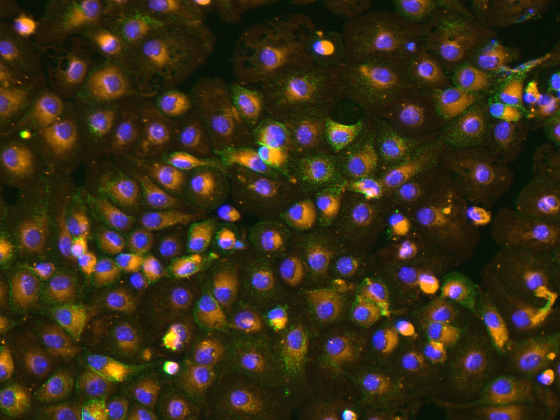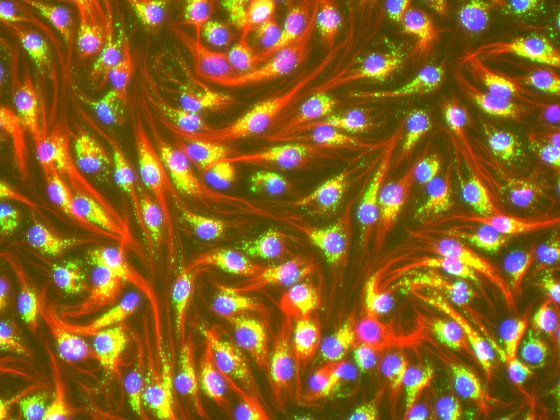LSEC receptors, ligands and cell biology
LSEC in culture:
Mönkemöller V*, Mao H*, Hübner W, Dumitriu G, Heimann P, Huser T, Kaltschmidt C, Kaltschmidt B, Øie CI. Primary rat LSEC preserve their characteristic phenotype after cryopreservation. Sci Rep, 2018 Oct 2;8(1):14657. https://doi.org/10.1038/s41598-018-32103-z
Martinez I, Nedredal GI, Øie CI, Warren A, Johansen O, Le Couteur DG, Smedsrod B. The influence of oxygen tension on the structure and function of isolated liver sinusoidal endothelial cells. Comp Hepatol 2008; 7:4-14. https://doi.org/10.1186/1476-5926-7-4
Elvevold, K., Nedredal, G.I., Revhaug, A., Bertheussen, K., Smedsrød, B. Long term preservation of high endocytic activity in primary cultures of pig liver sinusoidal endothelial cells. Eur J Cell Biol, 2005, 84: 749-764. https://doi.org/10.1016/j.ejcb.2005.05.003
Smedsrød B, Pertoft H, Gustafson S, Laurent TC. Scavenger functions of the liver endothelial cell. Biochem J, 1990; 266(2):313-27. https://doi.org/10.1042/bj2660313
Smedsrød B, Johansson S, Pertoft H. Studies in vivo and in vitro on the uptake and degradation of soluble collagen alpha1(I) chains in rat liver endothelial cells and Kupffer cells. Biochem J, 1985; 228:415-424. https://doi.org/10.1042/bj2280415
Smedsrød B, Pertoft H. Preparation of pure hepatocytes and reticuloendothelial cells in high yield from a single rat liver by means of Percoll centrifugation and selective adherence. J Leukoc Biool, 1985; 38(2):213-30. https://doi.org/10.1002/jlb.38.2.213
Smedsrød B, Pertoft H, Eriksson S, Fraser J, Laurent T. Studies in vitro on the uptake and degradation of sodium hyaluronate in rat liver endothelial cells. Biochem J, 1984; 223: 617-626. https://doi.org/10.1042/bj2230617
Fenestrations structure and regulation:
Zapotoczny B, Szafranska K, Lekka M, Ahluwia BS, McCourt P. Tuning of Liver Sieve: The Interplay between Actin and Myosin Regulatory Light Chain Regulates Fenestration Size and Number in Murine Liver Sinusoidal Endothelial Cells. International Journal of Molecular Sciences, 2022, 23(17), 9850; https://doi.org/10.3390/ijms23179850.
Scavenging/endocytosis:
Li R, Bhandari S, Martinez-Zubiaurre I, Bruun JA, Urbarova I, Smedsrød B, Simón-Santamaría J, Sørensen KK. Changes in the proteome and secretome of rat liver sinusoidal endothelial cells during early primary culture and effects of dexamethasone. PLoS ONE, 2022, Sep 2;17(9): e0273843. https://doi:10.1771/journal.pone.0273843.
Bhandari S, Li R, Simon-Santamaria J, McCourt P, Johansen SD, Smedsrød B, Martinez-Zubiaurre I, Sørensen KK. Transcriptome and proteome profiling reveal complementary scavenger and immune features of rat liver sinusoidal endothelial cells and liver macrophages. BMC Molecular and Cell Biology, 2020, 21:85 (25 p.). https://doi.org/10.1186/s12860-020-00331-9
de Haan W, Øie C, Benkheil M, Dheedene W, Vinckier S, Coppiello G, Aranguren XL, Beerens M, Jaekers J, Topal B, Verfaillie C, Smedsrød B, and Luttun A. Unraveling the transcriptional determinants of Liver Sinusoidal Endothelial Cell specialization. American Journal of Physiology-Gastrointestinal and Liver Physiology, 2020 Apr 1;318(4):G803-G815.https://doi.org/10.1152/ajpgi.00215.2019
Øie CI, Roepstorff K, Behrens C, Kristensen JB, Karpf DM, Bolt G, Kjalke M, Gudme C, Stennicke H, Smedsrød B, Appa RS. High-affinity von Willebrand factor binding does not affect the anatomical or hepatocellular distribution of factor VIII in rats. Journal of Thrombosis Haemostasis, 2016 Sep;14(9):1803-1813. https://doi.org/10.1111/jth.13406
Øie CI*, Snapkov I*, Elvevold K, Sveinbjørnsson B, Smedsrød B. FITC-conjugation markedly enhances hepatic clearance of N-formyl peptides. PLoS One. 2016 Aug 5;11(8). https://doi.org/10.1371/journal.pone.0160602
Li R*, Oteiza A*, Sørensen K, Mccourt PA, Olsen R; Smedsrød B, Svistounov D. Role of liver sinusoidal endothelial cells and stabilins in elimination of oxidized low-density lipoproteins. Am J Physiol - Gastrointest Liver Physiol 2011; Vol. 300 (1)s. G71 - G81.s https://doi.org/10.1152/ajpgi.00215.2010
Oteiza A*, Li R*, McCuskey RS, Smedsrød B, Sørensen KK. Effects of oxidized low-density lipoproteins on the hepatic microvasculature. Am J Physiol - Gastrointest Liver Physiol 2011; Vol. 301 (4). ISSN 0193-1857.s G684 - G693.s. https://doi.org/10.1152/ajpgi.00347.2010
Øie CI, Appa RS, Hilden I, Petersen HH, Gruhler A, Smedsrød B, Hansen JB. Rat liver sinusoidal endothelial cells (LSECs) express functional low density lipoprotein receptor-related protein-1 (LRP-1). Journal of Hepatology, 2011; 55:1346-1352. https://doi.org/10.1016/j.jhep.2011.03.013
Li R, McCourt PA, Schledzewski K, Goerdt S, Moldenhauer G, Liu X, Smedsrød B, Sørensen K. Endocytosis of Advanced Glycation End-Products in Bovine Choriocapillaris Endothelial Cells. Microcirculation, 2009; 16:640-655. https://doi.org/10.1080/10739680903133185
Nedredal GI, Elvevold K, Ytrebø LM, Fuskevåg O-M, Pettersen I, McCourt PAG, Bertheussen K, Smedsrød B, Revhaug A. Porcine liver sinusoidal endothelial cells contribute significantly to intrahepatic ammonia metabolism. Hepatology 2009, 50: 900-908. https://doi.org/10.1002/hep.23076
Elvevold K*, Simon-Santamaria J,* Hasvold H, McCourt PAG, Smedsrød B, Sørensen KK. Liver sinusoidal endothelial cells depend on mannose receptor mediated endocytic recruitment of lysosomal enzymes for normal degradation capacity. Hepatology, 2008; Dec;48(6):2007-15. https://doi.org/10.1002/hep.22527
Øie CI, Olsen R, Smedsrod B, and Hansen JB. Liver sinusoidal endothelial cells are the principal site for elimination of unfractionated heparin from the circulation. Am J Physiol - Gastrointest Liver Physiol 2008; 294:G520-528. https://doi.org/10.1152/ajpgi.00489.2007
Malovic I*, Sørensen KK*, Elvevold KK, Nedredal GI, Paulsen S, Erofeev AV, Smedsrød BH, McCourt PAG. The mannose receptor on murine liver sinusoidal endothelial cells is the main denatured collagen clearance receptor. Hepatology, 2007; 45: 1454-1461.https://doi.org/10.1002/hep.21639
Martin-Armas M, Simon-Santamaria J, Pettersen I, Moens U, Smedsrød B, Sveinbjørnsson B. Toll-like receptor 9 (TLR9) is present in murine liver sinusoidal endothelial cells (LSECs) and mediates the effect of CpG-oligonucleotides. Journal of Hepatology, 2006, 44(5):939-46. https://doi.org/10.1016/j.jhep.2005.09.020
Falkowska-Hansen B, Øynebråten I, Uhlin-Hansen L, Smedsrød B. Endocytosis and degradation of serglycin in liver sinusoidal endothelial cells. Mol Cell Biochem, 2006; Jul;287(1-2):43-52. https://doi.org/10.1007/s11010-005-9024-3
Hansen B, Longati P, Elvevold K, Nedredal GI, Schledzewski K, Olsen R, Falkowski M, Kzhyshkowska J, Carlsson F, Johansson S, Smedsrod B, Goerdt S, Johansson S, McCourt P. Stabilin-1 and stabilin-2 are both directed into the early endocytic pathway in hepatic sinusoidal endothelium via interactions with clathrin/AP-2, independent of ligand binding. Exp Cell Res, 2005,303:160-173. https://doi.org/10.1016/j.yexcr.2004.09.017
Nedredal GI, Elvevold KH, Ytrebo LM, Olsen R, Revhaug A, Smedsrod B. Liver sinusoidal endothelial cells represent an important blood clearance system in pig. Comp Hepatol, 2003; 2: 1-14. https://doi.org/10.1186/1476-5926-2-1
Seternes T, Sørensen K,Smedsrød B. Scavenger endothelial cells of vertebrates: A non-peripheral leucocyte system for high-capacity elimination of waste macromolecules. Proc. Natl. Acad, USA (PNAS) 99:7594-7597, 2002. https://doi.org/10.1073/pnas.102173299
Hansen B, Melkko J, Smedsrød B. Serum is a rich source of ligands for the scavenger receptor of hepatic scavenger endothelial cells. Mol Cell Biochem, 2002 Jan;229(1-2):63-72. https://doi.org/10.1023/A:1017919800347
Hansen B, Svistounov D, Nagai R, Horiuchi S, Smedsrød B. Advanced glycation end products impair the scavenger function of rat hepatic sinusoidal endothelial cells. Diabetologia, 2002 Oct;45(10):1379-88. https://doi.org/10.1007/s00125-002-0912-8
Hansen B, Arteta B, Smedsrød B. The physiological scavenger receptor function of hepatic sinusoidal endothelial and Kupffer cells is independent of scavenger receptor class A type I and II. Mol. Cell Biochem, 2002; 240: 1-8. https://doi.org/10.1023/A:1020660303855
McCourt PAG, Smedsrød BH, Melkko J, Johansson S. Characterization of a hyaluronan receptor on rat sinusoidal liver endothelial cells and its functional relationship to scavenger receptors. Hepatology, 1999, 30; 1276-1286. https://doi.org/10.1002/hep.510300521
Hellevik T, Martinez I, Olsen R, Toh B-H, Webster P, Smedsrød B. Transport of residual endocytosed products into terminal lysosomes occurs slowly in rat liver endothelial cells. Hepatology, 1998 Nov;28(5):1378-89. https://doi.org/10.1002/hep.510280529
Kawai Y, Smedsrød B, Elvevold K, Wake K. Uptake of lithium carmine by sinusoidal endothelial and Kupffer cells of the rat liver: new insights into the classical vital staining and the reticulo-endothelial system. Cell Tissue Res, 1998 May;292(2):395-410. https://doi.org/10.1007/s004410051069
Smedsrød B, Melkko J, Araki N, Sano H, Horiuchi S. Advanced glycation end products are eliminated by scavenger-receptor-mediated endocytosis in hepatic sinusoidal Kupffer and endothelial cells. Biochem J, 1997; 322: 567-573. https://doi.org/10.1042/bj3220567
Link to this page





